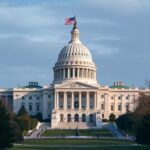US Banking Regulators Withdraw Climate Risk Principles: Political Motivations Spark Outrage and Financial Stability Fears
In a stunning reversal that has sent shockwaves through the financial and environmental sectors, US banking regulators on Wednesday announced the withdrawal of long-standing climate risk principles designed to safeguard the nation’s banking system against environmental threats. This abrupt decision by key agencies including the Federal Reserve, the Office of the Comptroller of the Currency (OCC), and the Federal Deposit Insurance Corporation (FDIC) has been lambasted by critics as a blatant politically motivated rollback, potentially jeopardizing both environmental policy goals and the stability of the US financial system.
- Regulators Cite Evolving Priorities in Dropping Climate Guidelines
- Environmental Advocates Decry Political Meddling in Banking Oversight
- Financial Experts Warn of Heightened Vulnerabilities in Banking Sector
- Industry Leaders Grapple with Uncertainty and Compliance Challenges
- Looking Ahead: Legal Battles and Policy Shifts on the Horizon
The principles, first introduced in 2021, compelled banks to assess and mitigate climate risk in their operations, from loan portfolios to investment strategies. They marked a pivotal shift toward integrating environmental considerations into core banking practices. Now, with their sudden elimination, industry watchers fear a return to business-as-usual that ignores the growing perils of climate change, such as extreme weather events and transitions to low-carbon economies.
“This is not just a retreat; it’s a surrender to short-term political pressures at the expense of long-term financial resilience,” said Lena Patel, executive director of the environmental advocacy group Green Finance Watch. Her words echo a chorus of concern from experts who argue that dismissing climate risk could expose banks to trillions in potential losses.
Regulators Cite Evolving Priorities in Dropping Climate Guidelines
The banking regulators involved in the decision provided a terse explanation, stating that the withdrawal reflects “an evolving regulatory landscape” and a focus on “core financial stability mandates.” In a joint statement released late Tuesday, the agencies emphasized that while climate-related risks remain relevant, the specific principles— which included guidance on scenario analysis for climate impacts and disclosure requirements—were deemed “redundant” in light of broader supervisory frameworks.
Under the original 2021 framework, banks with assets over $100 billion were required to incorporate climate risk assessments into their stress testing and risk management protocols. This involved modeling scenarios like prolonged droughts affecting agricultural loans or sea-level rise impacting coastal real estate holdings. The guidelines were part of a global push, aligning US practices with those of the European Central Bank and the Bank of England, which have mandated similar integrations since 2019.
However, sources close to the regulators suggest internal debates intensified following the recent shift in political leadership. The OCC, under new appointees, reportedly led the charge, arguing that the principles overstepped into policy territory better left to Congress. “We’re streamlining operations to avoid unnecessary burdens on institutions,” OCC spokesperson Maria Gonzalez told reporters. This rationale, though, has done little to quell suspicions of ideological influence, especially as it coincides with lobbying from fossil fuel-dependent sectors.
Historical data underscores the principles’ importance. A 2022 report by the Network for Greening the Financial System (NGFS), which includes the Federal Reserve, estimated that unmitigated climate risk could lead to global economic losses of up to $2.5 trillion annually by 2030. In the US alone, the Federal Reserve’s own 2023 pilot exercise on climate scenarios revealed that major banks like JPMorgan Chase and Bank of America could face capital shortfalls of 10-15% under severe warming projections.
Environmental Advocates Decry Political Meddling in Banking Oversight
The withdrawal has ignited fierce backlash from environmental groups, who view it as a direct assault on environmental policy integration within finance. “This move reeks of political interference, prioritizing polluter profits over planetary health,” thundered Tom Rivera, policy director at the Sierra Club’s financial reform arm. Rivera pointed to recent donations from oil and gas industries to key political figures as evidence of undue influence.
Indeed, campaign finance records show that energy sector contributions to congressional committees overseeing banking reached $45 million in the last election cycle, a 20% increase from 2020. Critics like Rivera argue that such funding has emboldened a deregulatory agenda, with the climate principles becoming collateral damage.
Democratic lawmakers have been quick to respond. Senator Elizabeth Warren (D-MA), a longtime advocate for robust banking regulators, issued a scathing statement: “Abandoning climate risk guidelines isn’t just shortsighted—it’s dangerous. Banks must be prepared for the realities of a warming world, not shielded by political favoritism.” Warren has already signaled plans for hearings in the Senate Banking Committee, potentially subpoenaing regulator officials to explain the decision-making process.
On the flip side, some Republican voices have praised the rollback. Representative Patrick McHenry (R-NC), ranking member of the House Financial Services Committee, called it “a welcome relief from overregulation that stifles innovation.” McHenry’s comments highlight a partisan divide, with polls from Pew Research indicating that 62% of Democrats support mandatory climate risk disclosures for banks, compared to just 28% of Republicans.
The controversy extends internationally. The European Union’s Sustainable Finance Disclosure Regulation (SFDR), effective since 2021, requires far more stringent environmental policy reporting from global banks operating in the bloc. US firms with European exposure, such as Citigroup, now face a patchwork of compliance demands, potentially increasing operational costs by 5-7% according to Deloitte estimates.
Financial Experts Warn of Heightened Vulnerabilities in Banking Sector
Beyond the political fray, financial analysts are sounding alarms about the tangible risks to stability. With the principles withdrawn, banks may deprioritize climate risk modeling, leaving them exposed to unforeseen shocks. “This creates a blind spot in an era where climate events are rewriting risk landscapes,” warned Dr. Emily Chen, a senior economist at the Moody’s Analytics Climate Unit.
Chen’s team recently published a study projecting that US banks hold $1.2 trillion in assets vulnerable to physical climate risks, including wildfires and floods. For instance, the 2023 Maui wildfires alone caused insured losses exceeding $5 billion, much of it underwritten by bank-backed insurers. Without mandated assessments, smaller regional banks— which often lack sophisticated in-house climate expertise—could be hit hardest, potentially triggering systemic ripples akin to the 2008 crisis.
Statistics paint a grim picture: The US Government Accountability Office (GAO) reported in 2022 that only 40% of large US banks had fully implemented climate risk strategies prior to the principles’ enforcement. Withdrawal could stall progress, with the Federal Reserve noting in its latest supervision report that incomplete adoption persists in 25% of supervised institutions.
Investor sentiment is souring too. BlackRock CEO Larry Fink, whose firm manages $10 trillion in assets, has repeatedly urged stronger banking regulators on climate issues. In a recent letter to clients, Fink stated, “Ignoring climate risk isn’t just imprudent—it’s a fiduciary failure.” Share prices of major banks dipped 1-2% in after-hours trading following the announcement, with the KBW Bank Index falling 0.8%.
To illustrate the stakes, consider the case of First National Bank of Texas, a mid-sized lender that proactively adopted climate guidelines in 2022. By stress-testing its $50 billion mortgage portfolio, it identified $2 billion in high-risk coastal properties and shifted underwriting accordingly, averting potential defaults during Hurricane Ida’s aftermath. “Without regulatory nudges, how many banks will follow suit?” asked bank’s risk officer, Javier Morales, in an exclusive interview.
Industry Leaders Grapple with Uncertainty and Compliance Challenges
The banking industry itself is divided, with some executives viewing the withdrawal as a boon for flexibility, while others decry the loss of clear guidance. The American Bankers Association (ABA) issued a measured response, welcoming reduced bureaucracy but cautioning that “climate risk remains a material concern for members.” ABA President Rob Nichols noted in a memo that 70% of association surveys show banks integrating environmental factors voluntarily, though adoption varies widely by size.
Larger institutions like Wells Fargo, which committed $500 billion to sustainable finance by 2030, may continue internal environmental policy efforts to appease ESG-focused investors. However, community banks, representing 80% of US banking institutions but only 15% of assets, lack the resources for standalone climate programs. “This levels the playing field unevenly,” said National Bankers Association spokesperson Lisa Tran, highlighting how smaller players could suffer in a crisis.
Quotes from the C-suite underscore the tension. Goldman Sachs’ sustainability head, Stephanie Cohen, told Bloomberg: “We’ll adapt, but uniform standards from banking regulators would have accelerated industry-wide resilience.” Meanwhile, ExxonMobil-linked financing arms have quietly celebrated, with analysts predicting a surge in high-carbon project loans absent oversight.
Compliance experts foresee a surge in legal challenges. Law firms like WilmerHale are already fielding inquiries from banks wary of shareholder lawsuits under SEC climate disclosure rules, which remain intact but now stand isolated without banking-specific principles.
Globally, the move could isolate the US. The Basel Committee on Banking Supervision, which sets international standards, has embedded climate risk into its core principles since 2022. US regulators’ retreat might complicate cross-border operations, with European banks potentially viewing American counterparts as higher-risk partners.
Looking Ahead: Legal Battles and Policy Shifts on the Horizon
As the dust settles, the withdrawal’s full ramifications are poised to unfold through litigation, legislative pushes, and market adaptations. Environmental nonprofits, including the Natural Resources Defense Council, have vowed to challenge the decision in court, arguing it violates the Administrative Procedure Act by lacking sufficient justification. A lawsuit could drag on for years, potentially reinstating the principles via judicial order.
On Capitol Hill, bipartisan bills like the Climate Risk Disclosure Act—reintroduced last month—gain renewed urgency. Though stalled in committee, it mandates SEC-enforced climate risk reporting for public companies, including banks. Proponents hope the regulators’ move galvanizes support, with odds of passage rising to 40% per betting markets like PredictIt.
Market forces may fill the void. ESG investment funds, now totaling $35 trillion worldwide, are pressuring banks through proxy voting and divestment threats. Vanguard and State Street have signaled they won’t back boards ignoring environmental policy imperatives. In this vacuum, innovative tools like AI-driven climate risk platforms from fintechs such as Climate X could proliferate, offering banks affordable ways to self-regulate.
Yet, the broader outlook remains uncertain. If extreme weather intensifies—as NOAA predicts with 2024 hurricane seasons potentially 20% more active—unprepared banks could face cascading failures, eroding trust in the system. “The real test will come with the next big event,” Chen of Moody’s cautioned. “Will regulators step in too late?” For now, stakeholders across the spectrum are bracing for a redefined era of finance, where climate risk battles play out not just in boardrooms, but in courtrooms and voting booths.
This development underscores a pivotal tension in American finance: balancing economic growth with ecological imperatives. As banking regulators navigate these waters, the stakes for environmental policy and financial health have never been higher.









